

Ancient Egypt: Crash Course World History #4. AncientEgyptMap.jpg (JPEG Image, 841x1474 pixels)
Old Kingdom 2686-2181 BC. 1st Intermediate Period 2181-2055 BC. Middle Kingdom 2055-1650 BC. 2nd Intermediate Period 1650-1550 BC. New Kingdom 1550-1069 BC. 3rd Intermediate Period 1069-664 BC. Late Period 664-332 BC. Achaemenid Egypt 525-332 BC. Ptolemaic and Roman Egypt. Art History: Ancient Egypt. Great Sphinx of Giza. The Great Sphinx of Giza, 2008 It is the largest monolith statue in the world, standing 73.5 metres (241 ft) long, 19.3 metres (63 ft) wide, and 20.22 m (66.34 ft) high.[1] It is the oldest known monumental sculpture, and is commonly believed to have been built by ancient Egyptians of the Old Kingdom during the reign of the Pharaoh Khafra (c. 2558–2532 BC).[1][2] Origin and identity The Great Sphinx partly under the sand, ca. 1870's.
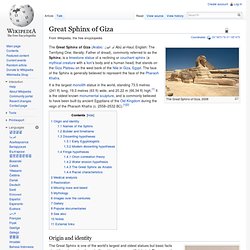
The Great Sphinx is one of the world's largest and oldest statues but basic facts about it, such as when it was built, and by whom, are still debated. Egyptian pyramids. Egyptian Symbols and Definitions. Djed It is believed that the Djed is a rendering of a human backbone.
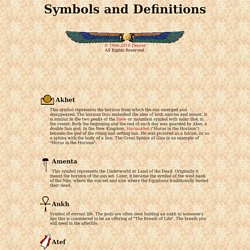
It represents stability and strength. It was originally associated with the creation god Ptah. Egyptian mathematics. Ancient Egyptian mathematics is the mathematics that was developed and used in Ancient Egypt circa 3000 BC to c.300 BC.

Overview[edit] Written evidence of the use of mathematics dates back to at least 3000 BC with the ivory labels found a Tomb U-j at Abydos. These labels appear to have been used as tags for grave goods and some are inscribed with numbers.[1] Further evidence of the use of the base 10 number system can be found on for instance the Narmer Macehead which depicts offerings of 400,000 oxen, 1,422,000 goats and 120,000 prisoners.[2] Egyptian astronomy. Egyptian astronomy begins in prehistoric times, in the Predynastic Period.
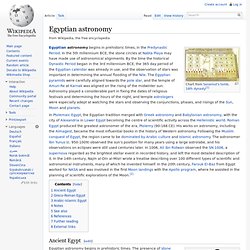
In the 5th millennium BCE, the stone circles at Nabta Playa may have made use of astronomical alignments. By the time the historical Dynastic Period began in the 3rd millennium BCE, the 365 day period of the Egyptian calendar was already in use, and the observation of stars was important in determining the annual flooding of the Nile. The Egyptian pyramids were carefully aligned towards the pole star, and the temple of Amun-Re at Karnak was aligned on the rising of the midwinter sun. Astronomy played a considerable part in fixing the dates of religious festivals and determining the hours of the night, and temple astrologers were especially adept at watching the stars and observing the conjunctions, phases, and risings of the Sun, Moon and planets.
Ancient Egypt[edit] Plan of a stone circle at Nabta, Egypt Egyptian astronomy begins in prehistoric times. Greco-Roman Egypt[edit] Egyptian Gods. Berserker. Berserkers (or berserks) were Norse warriors who are primarily reported in the Old Norse literature to have fought in a nearly uncontrollable, trance-like fury, a characteristic which later gave rise to the English word berserk.
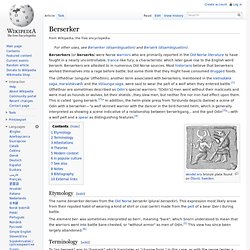
Berserkers are attested to in numerous Old Norse sources. Most historians believe that berserkers worked themselves into a rage before battle, but some think that they might have consumed drugged foods. The Úlfhéðnar (singular Úlfheðinn), another term associated with berserkers, mentioned in the Vatnsdœla saga, Haraldskvæði and the Völsunga saga, were said to wear the pelt of a wolf when they entered battle.[1] Úlfhéðnar are sometimes described as Odin's special warriors: "[Odin’s] men went without their mailcoats and were mad as hounds or wolves, bit their shields...they slew men, but neither fire nor iron had effect upon them. Etymology[edit] Divine Felines: Cats of Ancient Egypt. Papyrus of Ani: The Egyptian Book of the Dead. Duat. This article is about the Egyptian underworld.
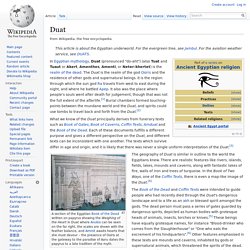
For the evergreen tree, see Jambul. For the aviation weather service, see DUATS. In Egyptian mythology, Duat (pronounced "do-aht") (also Tuat and Tuaut or Akert, Amenthes, Amenti, or Neter-khertet) is the realm of the dead. Housing - Ancient Egypt. There are no forests in Egypt so wood is scarce and is not used for house building.

The earliest inhabitants of Egypt lived in huts made from papyrus reeds. However, it was soon discovered that the mud left behind after the annual flooding of the Nile (inundation) could be made into bricks which could be used for building. Bricks were made by mixing mud and straw and leaving them to dry in the sun. The houses of the poorest people used one row of bricks while those that were not so poor used two or three rows. Although mud brick houses were relatively cheap to make, they were not very strong and began to crumble after a few years. The houses of the richest people were stronger because they could afford to build their home from stone. Most houses had at least three rooms and all houses had flat roofs which formed part of the living area.
Egyptian Make Up. Eg. History.